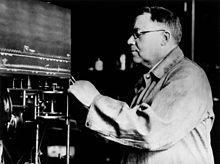Walter Cannon
Walter Bradford Cannon (born October 19, 1871 in Prairie du Chien , Wisconsin , † October 1, 1945 in Franklin , New Hampshire ) was an American physiologist.
Life
Walter Bradford Cannon was the son of a railroad worker, studied biology at Harvard College until 1896 and received his doctorate there in 1897. From 1896 to 1900 he had attended Harvard Medical School. He taught zoology there and became an assistant professor in 1902 .
In 1906 he succeeded Henry Pickering Bowditch as George Higginson Professor of Physiology at Harvard University . He held this professorship for physiology until 1942.
During the First World War (from 1914) he served as President of the American Physiological Society and studied traumatic shock as a response to threat from which many soldiers suffered.
He coined the term fight-or-flight response, which describes the reaction of animals to threat, and published on the subject (1915) Bodily Changes in Pain, Hunger, Fear and Rage .
He developed the concept of homeostasis ( homoestasis ) in his book The Wisdom of the Body (1932).
The Cannon-Bard theory - which Cannon worked out with his student Philip Bard (1898–1977) - states that an “emotional stimulus” produces two simultaneous reactions, physiological arousal and the perception of the emotion . Neither of the two reactions causes the other. The theory assumes that the physical processes are independent of the psychological ones. In 1906, Cannon was elected to the American Academy of Arts and Sciences and in 1908 to the American Philosophical Society . In 1914 he was admitted to the National Academy of Sciences and in 1932 to the Leopoldina , and in 1939 he was elected a foreign member of the Royal Society . In 1930 he became an honorary member ( Honorary Fellow ) of the Royal Society of Edinburgh and in 1942 of the then Academy of Sciences of the USSR . In 1934, Cannon gave the George M. Kober Lecture .
Walter Cannon investigated the swallowing and digestive processes with the X-ray contrast media barium subnitrate and barium sulfate. He died of radiation cancer in 1945.
Fonts (selection)
- The mechanical factors of digestion. London 1911.
- Bodily Changes in Pain, Hunger, Fear and Rage: An Account of Recent Researches into the Function of Emotional Excitement . Appleton, New York 1915.
- The James-Lange theory of emotion: A critical examination and an alternative theory. In: American Journal of Psychology , 39, 1927, pp. 106-124.
- The Wisdom of the Body . WW Norton, New York 1932.
Web links
- Literature by and about Walter Cannon in the catalog of the German National Library
- harvardsquarelibrary Walter Cannon
- DS Goldstein, IJ Kopin: Evolution of concepts of stress. In: Stress , 2007 Jun, 10 (2), pp. 109-120, PMID 17514579 . Clinical Neurocardiology Section, National Institute of Neurological Disorders and Stroke, Bethesda MD 20892-1620
- Entry for Cannon, Walter Bradford (1871-1945) in the Archives of the Royal Society , London
- Cornelius Borck: The wisdom of homeostasis and the freedom of the body. Walter B. Cannons integrated theory of the organism , in: Zeithistorische Forschungen / Studies in Contemporary History 11 (2014), pp. 472–477.
Individual evidence
- ^ Encyclopedia.com: Walter Bradford Cannon .
- ↑ Barbara I. Tshisuaka: Cannon, Walter Bradford. In: Werner E. Gerabek , Bernhard D. Haage, Gundolf Keil , Wolfgang Wegner (eds.): Enzyklopädie Medizingeschichte. De Gruyter, Berlin / New York 2005, ISBN 3-11-015714-4 , p. 229.
- ↑ Walter B. Cannon: Anger, hunger, fear, and pain: a physiology of emotions . From d. Engl. Transl. by Helmut Junker, ed. by Thure von Uexküll. Urban & Schwarzenberg, Munich / Berlin / Vienna 1975, first engl. Edition 1915
- ^ Member History: Walter B. Cannon. American Philosophical Society, accessed May 29, 2018 .
- ^ Fellows Directory. Biographical Index: Former RSE Fellows 1783–2002. Royal Society of Edinburgh, accessed October 16, 2019 .
- ^ Foreign members of the Russian Academy of Sciences since 1724. Walter Bradford Cannon. Russian Academy of Sciences, accessed September 6, 2015 .
- ↑ Barbara I. Tshisuaka: Cannon, Walter Bradford. 2005, p. 229.
| personal data | |
|---|---|
| SURNAME | Cannon, Walter |
| ALTERNATIVE NAMES | Cannon, Walter Bradford (full name) |
| BRIEF DESCRIPTION | American physiologist |
| DATE OF BIRTH | October 19, 1871 |
| PLACE OF BIRTH | Prairie du Chien, Wisconsin |
| DATE OF DEATH | October 1, 1945 |
| Place of death | Franklin , New Hampshire |

